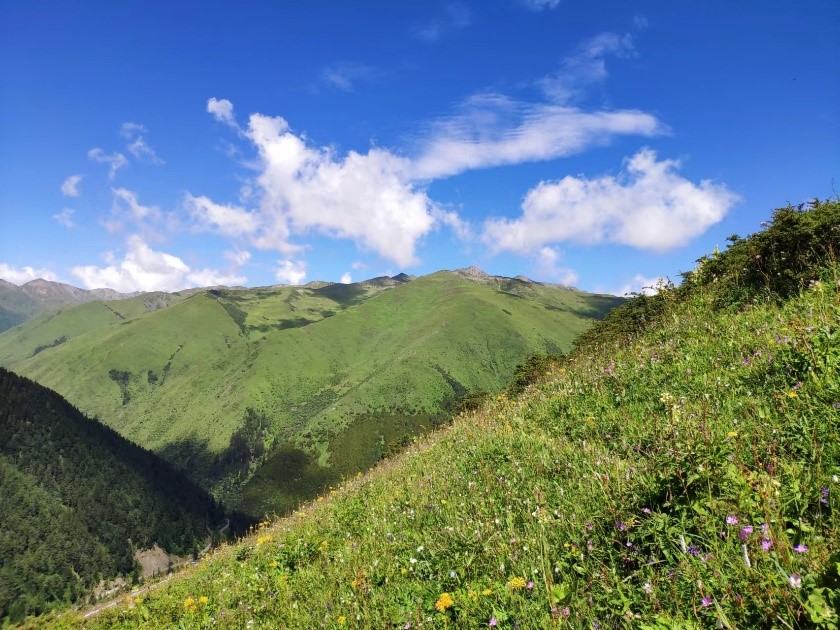Usually, we identify plants by their showy and delicate flowers. Because flowers are selected to be more attractive compared with leaves, stems, or the hidden roots for most species. However, sometimes, when flowers from different but related species are similar, even the botanists might feel confused and misidentify them, which might lead to mistakes. So how can we identify them correctly?
Views 2238
Reading time 3 min
published on Jul 19, 2023
Imagine you are driving in the Hengduan Mountains. The wind from the valley mixed with the sunshine comfort you. You see some plants by the road. They are short, the leaves are pinnate and nothing special. But the flowers are lovely, light, with long and elegant tube. The corolla is bright magenta, and what amazes you is the S-shaped beaked galea. You drive forward, from mountains to mountains, and you see spectacular seas of these kinds of flowers again and again in alpine meadows. You notice slight variations in these flowers across the mountains; however, the difference is fine, and you are not the expert. You can’t help to ask yourself how many species you have seen, and what are the specific differences between them.
We are curious about it like you. These adorable flowers belong to the Pedicularis siphonantha complex. According to the Flora of China, 11 species have been scientifically described so far. To find out how many species there are and what the differences are between the species in this complex, we widely collected the populations of species in the Himalaya-Hengduan Mountains region. Totally, we collected 10 known species and two unknown species. Then we used the DNA barcoding method to identify them. We found that all the species can be well identified except some populations. For example, the populations of P. milliana and unknown species in the Lijiang region show possible genetic relationship not only with P. millana but also with P. sigmoidea. The populations of P. dolichosiphon show possible genetic relationship with P. tenuituba and P. leptosiphon. In addition, the unknown species we found in Dongchuan didn’t belong to any described species.
To answer why some populations are genetically associated with other species, we used phylogenetic analysis to explore the relationship among them. We found that some genes in chloroplast DNA inherited from the female parent supported the close relationship between these populations and the species which have the same or neighboring geographical distribution. However, the gene in nuclear DNA inherited from both parents supported the close relationship of the species with the same phenotype. From integrated evidence, we concluded that these populations might originate from hybridization or introgression. For example, today in Lijiang there is marginal distribution of P. milliana, and the distribution of P. sigmoidea is nearby. The ancient hybridization might have happened there long ago, and the ancestor of P. milliana might be the male parent, while the ancestor of P. sigmoidea might be the female parent. Then the hybrids backcrossed with the male parent continually and the hybrids looked more like P. milliana, but the chloroplast inherited from P. sigmoidea. So, we find the populations of P. milliana in Lijiang have strong genetic association with P. sigmoidea.
Furthermore, to understand the origin and speciation of these flowers, we conducted biogeographical analysis. Our results showed that the ancestor of these species originated from the Southern Hengduan Mountains and dispersed fast around the Himalaya-Hengduan Mountains. The species divergence mainly occurred during the Pliocene (2–5 Million years ago). All the species have relatively isolated geographical distribution. Therefore, we concluded that the ancestor of these species might have had high adaptation in alpine meadow that allowed them to disperse around within a short time. The strong geological activity during the Pliocene in the Himalaya-Hengduan Mounatins might have led to an isolated habitat and contributed to speciation. At the same time, some widely distributed species such as P. miliana might have expanded in population and overlapped with P. sigmidea, which resulted in hybridization or introgression. This is the reason we felt puzzled about the species delimitation.
Pedicualris is a representative taxon of diversification in the Himalaya-Hengduan Mountains. Our work revealed the main process of species diversification in this region. Our analyses suggest the mountain uplift drives the allopatric speciation, and the secondary contact of related species may lead to hybridization or introgression.
Finally, compared with traditional methods based mainly on the morphology, molecular methods are more advanced and can answer scientific problems we could not figure out in the past. This is why the technology is so popular nowadays. However, overdependence on molecular methods to identify species might narrow our understanding of the nature of life and diminish the original pleasure of taxonomy.
Original Article:
Liu, R., Wang, H., Yang, J.-B., Corlett, R. T., Randle, C. P., Li, D.-Z., & Yu, W.-B. (2022). Cryptic Species Diversification of the Pedicularis siphonantha Complex (Orobanchaceae) in the Mountains of Southwest China Since the Pliocene. Frontiers in Plant Science, 13. https://doi.org/10.3389/fpls.2022.811206
 Plant Biology
Plant Biology



